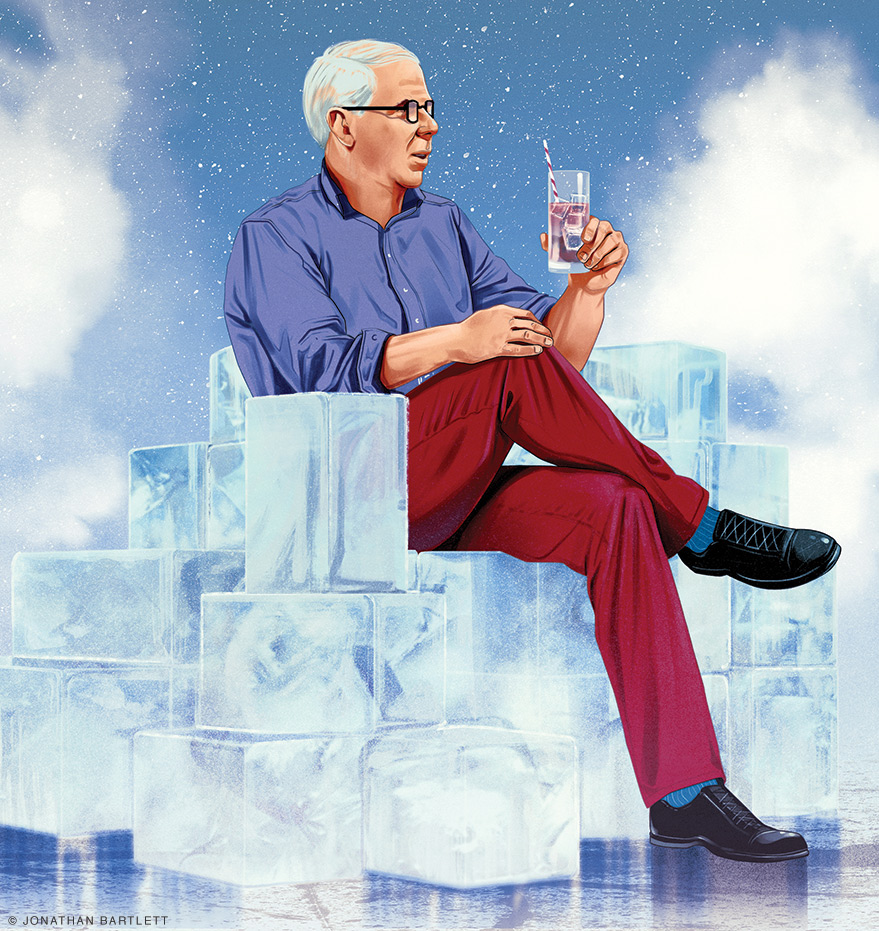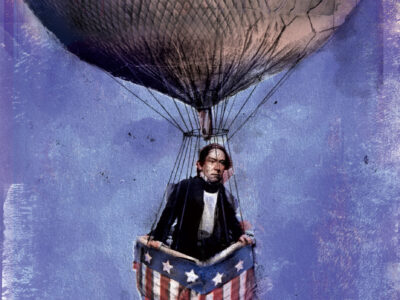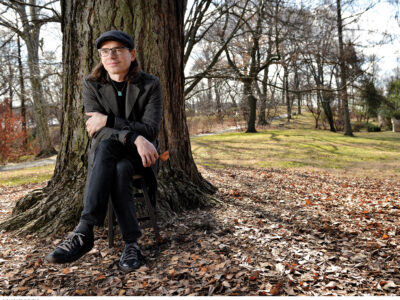
Why the country’s foremost refrigeration expert believes that “ice defines Americans.”
Historian Jonathan Rees C’88 is chill. As one of the world’s leading experts on the history of refrigeration, he knows the cold, hard facts about today’s ice age.
Starting in the early 1800s, American inventors and companies set out to control coldness, a technological and commercial process that has since revolutionized life around the world. “Ice came to define what it means to be an American,” writes Rees, the author of three books on the subject—Refrigeration Nation: A History of Ice, Appliances, and Enterprise in America (2013); Refrigerator (2015); and Before the Refrigerator: How We Used to Get Ice (2018).
A professor at Colorado State University Pueblo, Rees has become the go-to source for his cool knowledge, from New York Times reporters to random curiosity seekers. “They go to Google and find me pretty quickly,” says Rees. The most common question he gets is ‘How did early refrigerators differ from ones today?’ They are much the same, according to him, because they use identical technology—a refrigerant changes from a gas to a liquid, drawing heat from the surrounding area. “All the real improvements have to do with energy efficiency, mass production, and reliability,” he says. Since the 1970s, refrigerators’ energy use has fallen by two-thirds.
The world’s ice addiction began in 1806 when Boston merchant Frederic Tudor, later dubbed the “Ice King,” sent 80 tons of ice packed in sawdust to the tropical island Martinique. “Slippery speculation,” sniffed the Boston Gazette. Later he routinely shipped his exotic product to far-flung Calcutta and Australia, accepting as a cost of doing business that 30 percent or more would melt en route.
Soon gangs of ice cutters roamed northern states. They worked for regional companies that vertically integrated the industry from harvest and storage to distribution. They even intruded on solitude-seeking Henry David Thoreau, who wrote in the 1840s that 100 ice harvesters descended on Walden Pond from sunup to sundown for 16 straight days. Ice from his deep pond was famed for its purity. By the 1850s as many as 25,000 men harvested ice from the Hudson River alone.
Southerners and northerners alike craved iced drinks. “I think there is but a single specialty with us,” wrote Mark Twain. “One thing … can be called by the wide name ‘American.’ That is the national devotion to ice-water.” The brewing and meatpacking industries became early adopters. Ice prevented spoilage, and it was a must for lager makers, boosting beer’s popularity and forever changing Americans’ drinking habits. Businesses ranging from florists to mortuaries followed suit. By 1900 express trains sped refrigerated strawberries north, and 4,000 ice cream peddlers strolled New York City’s streets.
Other nations, largely due to cultural differences, lagged. Italians feared that “ice injures rather than soothes the palate and the stomach,” according to Rees. “Whoever heard of an American without his icebox? It is his country’s emblem. It asserts his nationality as conclusively as the Stars and Stripes,” wrote a British travel writer in 1914. Fewer than 10 percent of British homes in 1957 had refrigerators compared to 90 percent in the US, reported the Times of London. Americans have always had the world’s largest refrigerators—an average of 17.5 cubic feet compared to eight in Russia (as of 1998).
What explains America’s frosty leadership? “Our nation is a place of enormous abundance,” says Rees. “We’ve always had an enormous amount of food. To say that ice defines Americans has a lot to do with the fact that we have all this food and then can preserve it to make it even more cheap and plentiful.”
After the Civil War, American inventors perfected warehouse-sized ice machines that produced tons of ice a day. Between 1870 and 1920 Americans had more ice than anyone, according to Rees. “Those years were a transition point,” he says. “People went from only having access to perishable foods briefly to having them all the time. It felt like we were the richest country on Earth. Ice ended seasons. Suddenly you could eat anything you wanted anytime you wanted to.”
Machine-made and natural ice companies battled for market supremacy. A turning point came in 1927 when GE unveiled the first safe, reliable household refrigerator. Now anyone could make ice cubes from pure tap water. Housewives ditched unhygienic, inefficient iceboxes. Soon “the ice man” was extinct. During the Great Depression, refrigerator prices plunged. By 1944, 85 percent of homes had a fridge, an adoption curve faster than the rate at which Americans bought color TVs and washing machines.
To spark sales, manufacturers added frills like vegetable crispers, ice-cube trays, and butter compartments. The only major fridge technology breakthrough in the past century, according to Rees, came with the launch of frost-free freezers in 1957. “Before then, periodically shutting down the refrigerator to get rid of all the frost on the back was just one more thing for Mom to do,” he says.
A history and political science major at Penn, Rees came to the subject by chance. While working on his PhD thesis on the steel industry at the University of Wisconsin, he routinely studied in its engineering library. Every day when the elevator doors opened on his favored floor, the first thing he saw in the stacks were hundred-year-old bound copies of the trade journal Ice and Refrigeration.
“I cracked one open and saw that lots of refrigeration plants burned down. That seemed a little ironic,” Rees recalls. He learned that in the 1880s refrigeration plants used ammonia as a refrigerant. It had the unfortunate habit of exploding under pressure. With his interest piqued, he wrote his first scholarly paper on the subject. Realizing that historians had given America’s frigid past the cold shoulder, Rees made the niche his own.
He has recently shifted subjects. His new book The Fulton Fish Market: A History explores the 201-year-old lore of this New York City icon. “Its magic was that it was a major blue-collar industrial distribution hub stuck in the middle of a white-collar borough,” says Rees. Having recently moved to the Bronx from lower Manhattan, the Fish Market has become a less colorful place. “Sanitation destroyed its romance,” he sighs.
Now Rees has a new hot topic—a history of the chile pepper in America. “Its global voyage from its origin in southern Central America is well known, but its American adoption less so,” he says.
The subject is close to his heart—and palate. His adopted hometown of Pueblo, Colorado, grows what he regards the world’s best pepper—the Pueblo chile. Its unparalleled blend of heat and flavor, he notes, comes from this southern Colorado town’s special blend of sun, soil, and water.
“I like that feeling of learning a lot about something that’s completely new,” Rees says. “And in history, I’ll never run out of that.”
—George Spencer




